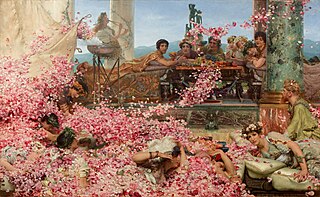
Sir Lawrence Alma-Tadema was a Dutch painter who later settled in the United Kingdom, becoming the last officially recognised denizen in 1873. Born in Dronryp, the Netherlands, and trained at the Royal Academy of Antwerp, Belgium, he settled in London, England in 1870 and spent the rest of his life there.

In Greek mythology, Silenus was a companion and tutor to the wine god Dionysus. He is typically older than the satyrs of the Dionysian retinue (thiasos), and sometimes considerably older, in which case he may be referred to as a Papposilenus. Silen and its plural sileni refer to the mythological figure as a type that is sometimes thought to be differentiated from a satyr by having the attributes of a horse rather than a goat, though usage of the two words is not consistent enough to permit a sharp distinction.

In Greek mythology, maenads were the female followers of Dionysus and the most significant members of the thiasus, the god's retinue. Their name, which comes from μαίνομαι, literally translates as 'raving ones'. Maenads were known as Bassarids, Bacchae, or Bacchantes in Roman mythology after the penchant of the equivalent Roman god, Bacchus, to wear a bassaris or fox skin.

In Greek mythology, Agave, the daughter of Cadmus, was a princess of Thebes and the queen of the Maenads, followers of Dionysus.
In Greek mythology, Pitys was an Oread nymph who was pursued by Pan.

Laurence Alma-Tadema CBE, born Laurense Tadema, was a British writer of the late 19th and early 20th centuries who worked in many genres.

The Roses of Heliogabalus is an oil painting by the Anglo-Dutch artist Sir Lawrence Alma-Tadema, from 1888. It depicts the young Roman emperor Elagabalus hosting a banquet. It is held in a private collection.
The Lenaia was an annual Athenian festival with a dramatic competition. It was one of the lesser festivals of Athens and Ionia in ancient Greece. The Lenaia took place in Athens in Gamelion, roughly corresponding to January. The festival was in honour of Dionysus Lenaios. There is also evidence the festival also took place in Delphi.

John William Godward was an English painter from the end of the Neo-Classicist era. He was a protégé of Sir Lawrence Alma-Tadema, but his style of painting fell out of favour with the rise of modern art.

The Sterling and Francine Clark Art Institute, commonly referred to as the Clark, is an art museum and research institution located in Williamstown, Massachusetts, United States. Its collection consists of European and American paintings, sculpture, prints, drawings, photographs, and decorative arts from the fourteenth to the early twentieth century. The Clark, along with the Massachusetts Museum of Contemporary Art and the Williams College Museum of Art (WCMA), forms a trio of art museums in the Berkshires. The institute also serves as a center for research and higher learning. It is home to various research and academic programs, which include the Fellowship Program and the Williams College Graduate Program in the History of Art, as well as one of the most distinguished research libraries in the country, with more than 295,000 volumes in over 72 languages. The Clark is visited by 200,000 people a year, and offers many educational programs for visitors of all ages throughout the year.
The Kleophon Painter is the name given to an anonymous Athenian vase painter in the red-figure style who flourished in the mid-to-late 5th century BC. He is thus named because one of the works attributed to him bears an inscription in praise of a youth named "Kleophon". He appears to have been originally from the workshop of Polygnotos, and in turn to have taught the so-called Dinos Painter. Three vases suggest a collaboration with the Achilles Painter, while a number of black-figure works have also been attributed to him by some scholars.

Spring is an 1894 oil-on-canvas painting by the Anglo-Dutch artist Lawrence Alma-Tadema, which has been in the collection of the J. Paul Getty Museum in Los Angeles, California, since 1972. The painting relates the Victorian custom of children collecting flowers on May Day back to an Ancient Roman spring festival, perhaps Cerealia or Floralia or Ambarvalia, although the details depicted in the painting do not correspond to any single Roman festival. It was the inspiration for the scene of Julius Caesar's triumphal entry into Rome in the 1934 film Cleopatra.

Ecstatic dance is a form of dance in which the dancers, sometimes without the need to follow specific steps, release themselves to the rhythm and move freely as the music takes them, leading to trance and a feeling of ecstasy. The effects of ecstatic dance begin with ecstasy itself, which may be experienced in differing degrees. Dancers are described as feeling connected to others, and to their own emotions. The dance serves as a form of meditation, helping people to cope with stress and to attain serenity.

John Reinhard Weguelin was an English painter and illustrator, active from 1877 to after 1910. He specialized in figurative paintings with lush backgrounds, typically landscapes or garden scenes. Weguelin emulated the neo-classical style of Edward Poynter and Lawrence Alma-Tadema, painting subjects inspired by classical antiquity and mythology. He depicted scenes of everyday life in ancient Greece and Rome, as well as mythological subjects, with an emphasis on pastoral scenes. Weguelin also drew on folklore for inspiration, and painted numerous images of nymphs and mermaids.

Jan Verhas or Jan Frans Verhas was a Belgian painter of the Realist school. He was known for his portraits and genre paintings often depicting children of the Belgian bourgeoisie. Jan Verhas also painted history paintings, coastal landscapes, beach scenes, seascapes and the occasional still life of flowers. He was an important representative of the Realist movement in Belgium.

Laura Theresa, Lady Alma-Tadema was a British painter specialising in domestic and genre scenes of women and children. Eighteen of her paintings were exhibited at the Royal Academy. Her husband, Sir Lawrence Alma-Tadema, was one of the most prominent Victorian painters.

Anna Alma-Tadema was a British artist and suffragette.

A Reading from Homer is an oil-on-canvas painting executed in 1885 by the English artist Lawrence Alma-Tadema. It depicts an imaginary festival scene from ancient Greece with youth reading poetry to a small audience on a marble balcony overlooking the sea. The painting has been in the collection of the Philadelphia Museum of Art since 1924.

Mischief and Repose is an 1895 oil-on-canvas painting by British artist John William Godward. It has been held by the J. Paul Getty Museum in Los Angeles since 1979. Godward painted a second, smaller painting, with a different composition but the same title, in 1909.
The Bath of Psyche is an oil painting by Frederic Leighton, first exhibited in 1890. It is in the collection of Tate Britain.
















